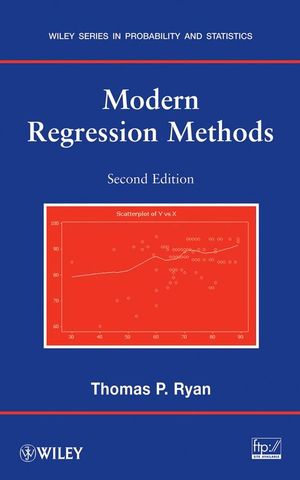|
Textbook
Modern Regression Methods, 2nd EditionISBN: 978-0-470-08186-0
Hardcover
672 pages
November 2008, ©2009
 This is a Print-on-Demand title. It will be printed specifically to fill your order. Please allow an additional 15-20 days delivery time. The book is not returnable.
|
||||||
1. Introduction.
1.1 Simple Linear Regression Model.
1.2 Uses of Regression Models.
1.3 Graph the Data!
1.4 Estimation of ß0 and ß1.
1.5 Inferences from Regression Equations.
1.6 Regression Through the Origin.
1.7 Additional Examples.
1.8 Correlation.
1.9 Miscellaneous Uses of Regression.
1.10 Fixed Versus Random Regressors.
1.11 Missing Data.
1.12 Spurious Relationships.
1.13 Software.
1.14 Summary.
Appendix.
References.
Exercises.
2. Diagnostics and Remedial Measures.
2.1 Assumptions.
2.2 Residual Plots.
2.3 Transformations.
2.4 Influential Observations.
2.5 Outliers.
2.6 Measurement Error.
2.7 Software.
2.8 Summary.
Appendix.
References.
Exercises.
3. Regression with Matrix Algebra.
3.1 Introduction to Matrix Algebra.
3.2 Matrix Algebra Applied to Regression.
3.3 Summary.
Appendix.
References.
Exercises.
4. Introduction to Multiple Linear Regression.
4.1 An Example of Multiple Linear Regression.
4.2 Centering And Scaling.
4.3 Interpreting Multiple Regression Coefficients.
4.4 Indicator Variables.
4.5 Separation or Not?
4.6 Alternatives to Multiple Regression.
4.7 Software.
4.8 Summary.
References.
Exercises.
5. Plots in Multiple Regression.
5.1 Beyond Standardized Residual Plots.
5.2 Some Examples.
5.3 Which Plot?
5.4 Recommendations.
5.5 Partial Regression Plots.
5.6 Other Plots For Detecting Influential Observations.
5.7 Recent Contributions to Plots in Multiple Regression.
5.8 Lurking Variables.
5.9 Explanation of Two Data Sets Relative to R2.
5.10 Software.
5.11 Summary.
References.
Exercises.
6. Transformations in Multiple Regression.
6.1 Transforming Regressors.
6.2 Transforming Y.
6.3 Further Comments on the Normality Issue.
6.4 Box-Cox Transformation.
6.5 Box-Tidwell Revisited.
6.6 Combined Box-Cox and Box-Tidwell Approach.
6.7 Other Transformation Methods.
6.8 Transformation Diagnostics.
6.9 Software.
6.10 Summary.
References.
Exercises.
7. Selection of Regressors.
7.1 Forward Selection.
7.2 Backward Elimination.
7.3 Stepwise Regression.
7.4 All Possible Regressions.
7.5 Newer Methods.
7.6 Examples.
7.7 Variable Selection for Nonlinear Terms.
7.8 Must We Use a Subset?
7.9 Model Validation.
7.10 Software.
7.11 Summary.
Appendix.
References.
Exercises.
8. Polynomial and Trigonometric Terms.
8.1 Polynomial Terms.
8.2 Polynomial-Trigonometric Regression.
8.3 Software.
8.4 Summary.
References.
Exercises.
9. Logistic Regression.
9.1 Introduction.
9.2 One Regressor.
9.3 A Simulated Example.
9.4 Detecting Complete Separation, Quasicomplete Separation and Near Separation.
9.5 Measuring the Worth of the Model.
9.6 Determining the Worth of the Individual Regressors.
9.7 Confidence Intervals.
9.8 Exact Prediction.
9.9 An Example With Real Data.
9.10 An Example of Multiple Logistic Regression.
9.11 Multicollinearity in Multiple Logistic Regression.
9.12 Osteogenic Sarcoma Data Set.
9.13 Missing Data.
9.14 Sample Size Determination.
9.15 Polytomous Logistic Regression.
9.16 Logistic Regression Variations.
9.17 Alternatives to Logistic Regression.
9.18 Software for Logistic Regression.
9.19 Summary.
Appendix.
References.
Exercises.
10. Nonparametric Regression.
10.1 Relaxing Regression Assumptions.
10.2 Monotone Regression.
10.3 Smoothers.
10.4 Variable Selection.
10.5 Important Considerations in Smoothing.
10.6 Sliced Inverse Regression.
10.7 Projection Pursuit Regression.
10.8 Software.
10.9 Summary.
Appendix.
References.
Exercises.
11. Robust Regression.
11.1 The Need for Robust Regression.
11.2 Types of Outliers.
11.3 Historical Development of Robust Regression.
11.4 Goals of Robust Regression.
11.5 Proposed High Breakdown Point Estimators.
11.6 Approximating HBP Estimator Solutions.
11.7 Other Methods for Detecting Multiple Outliers.
11.8 Bounded Influence Estimators.
11.9 Multistage Procedures.
11.10 Other Robust Regression Estimators.
11.11 Applications.
11.12 Software for Robust Regression.
11.13 Summary.
References.
Exercises.
12. Ridge Regression.
12.1 Introduction.
12.2 How Do We Determine K?
12.3 An Example.
12.4 Ridge Regression for Prediction.
12.5 Generalized Ridge Regression.
12.6 Inferences in Ridge Regression.
12.7 Some Practical Considerations.
12.8 Robust Ridge Regression?
12.9 Recent Developments in Ridge Regression.
12.10 Other Biased Estimators.
12.11 Software.
12.12 Summary.
Appendix.
References.
Exercises.
13. Nonlinear Regression.
13.1 Introduction.
13.2 Linear Versus Nonlinear Regression.
13.3 A Simple Nonlinear Example.
13.4 Relative Offset Convergence Criterion.
13.5 Adequacy of the Estimation Approach.
13.6 Computational Considerations.
13.7 Determining Model Adequacy.
13.7.1 Lack-of-Fit Test.
13.8 Inferences.
13.9 An Application.
13.10 Rational Functions.
13.11 Robust Nonlinear Regression.
13.12 Applications.
13.13 Teaching Tools.
13.14 Recent Developments.
13.15 Software.
13.16 Summary.
Appendix.
References.
Exercises.
14. Experimental Designs for Regression.
14.1 Objectives for Experimental Designs.
14.2 Equal Leverage Points.
14.3 Other Desirable Properties of Experimental Designs.
14.4 Model Misspecification.
14.5 Range of Regressors.
14.6 Algorithms for Design Construction.
14.7 Designs for Polynomial Regression.
14.8 Designs for Logistic Regression.
14.9 Designs for Nonlinear Regression.
14.10 Software.
14.11 Summary.
References.
Exercises.
15. Miscellaneous Topics in Regression.
15.1 Piecewise Regression and Alternatives.
15.2 Semiparametric Regression.
15.3 Quantile Regression.
15.4 Poisson Regression.
15.5 Negative Binomial Regression.
15.6 Cox Regression.
15.7 Probit Regression.
15.8 Censored Regression and Truncated Regression.
15.8.1 Tobit Regression.
15.9 Constrained Regression.
15.10 Interval Regression.
15.11 Random Coefficient Regression.
15.12 Partial Least Squares Regression.
15.13 Errors-in-Variables Regression.
15.14 Regression with Life Data.
15.15 Use of Regression in Survey Sampling.
15.16 Bayesian Regression.
15.17 Instrumental Variables Regression.
15.18 Shrinkage Estimators.
15.19 Meta-Regression.
15.20 Classification and Regression Trees (CART).
15.21 Multivariate Regression.
References.
Exercises.
16. Analysis of Real Data Sets.
16.1 Analyzing Buchanan’s Presidential Vote in Palm Beach County in 2000.
16.2 Water Quality Data.
16.3 Predicting Lifespan?
16.4 Scottish Hill Races Data.
16.5 Leukemia Data.
16.6 Dosage Response Data.
16.7 A Strategy for Analyzing Regression Data.
16.8 Summary.
References.
Answers to Selected Exercises.
Statistical Tables.
Author Index.
Subject Index.



